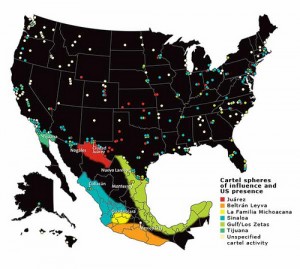Sun 1 Nov 2009
Robert Almonte, a retired Deputy Chief of the El Paso Police Department, spent most of his career investigating Mexican drug dealers and the Mexican drug trade. During his research, he began to encounter many of the same saints displayed in the stash homes, in vehicles and even on Mexican drug dealers. Almonte came to learn that these saints are being used as protection against law enforcement officials.
The most common saints:
La Virgen de Guadalupe: Patron Saint of forgiveness for past crimes
Torimo Romo: rescued migrants in the desert
Santo Nino de Atocha: the boy pilgrim, patron saint of prisoners and travelers
St. Jude: Patron Saint of lost causes-helps to get through difficult situations (like trafficking drugs)
St. Ramone: Patron Saint of secrets and silence. Drug traffickers will tape a penny over St. Ramone’s mouth to keep their deals a secret.
Jesus Malverde: Angel of Poor, Mexican Robin Hood
San Simone: from Guatemala, gaining popularity in Mexico-Patron Saint of undocumented immigrants as well as Patron Saint of Gamblers and Drunkards
Juan Soldado: Patron Saint of illegal aliens.
The most famous: La Santa Muerte (Saint Death): La Santa Muerte is not canonized by the Catholic Church, in fact, she is not even recognized by the Catholic Church. La Santa Muerte is a skeleton dressed similar to the Virgen Mary. Whereas the Virgen Mary only listens to the wealthy and well-off, it is believed by many Mexicans that La Santa Muerte hears prayers from the poor and criminal-minded. La Santa Muerte is usually seen wearing three colors: red=love, white=good luck, and black=protection. La Santa Muerte has recently become associated with violence in Mexico, where drug dealers will execute people and offer their heads to La Santa Muerte. Violence linked to Saint Death has not been seen yet in the United States.
These saints are usually seen as images on candles with prayers on them. The other most common way these idols are displayed are on small cards that can be kept in a wallet or displayed on the dashboard of a vehicle. Besides the saints, another common card is the Mano Poderosa-which is the image of Jesus’ hand with a religious figure on each of His fingers. Mexican drug traffickers carry this around to literally have God’s hand protecting them from law enforcement. Pendants of the saints worn around the necks of drug traffickers are incredibly common as well.
Many Mexican drug dealers and traffickers also believe in brujas (witches) and curanderos (healers). Brujas are used to make hexes against particular narcotics officers. Curanderos are known to prepare medicines from herbs and plants. They also lead their followers in prayer and perform a “limpia” where they used a branch to “clean” the drug trafficker.
Many Mexicans are now becoming involved in Santeria, which is the combination of African Gods and Catholicism. The drug traffickers want as much good luck as they can get, so they are trying this religion that is popular in Cuba and the Caribbean.
Other commonly seen idols among Mexican drug traffickers are: Tweety Bird-who in cartoons always seems to escape Sylvester, and Scarface.
Many drug traffickers have more than one idol, believing that “more is better.” Besides just praying to these idols, drug traffickers have gotten creative. In Kentucky, pounds and pounds of marijuana were found being transported in a four-foot statue of St. Jude.
Narcotics officers now have an extra clue to look for when searching a suspected stash house or when pulling over a suspicious driver. As more law enforcement agents learn about the Patron Saints of the Mexican Drug Underworld, one can’t help but wonder, who’s side are the saints on?



 Chavez, from Chihuahua, is being criticized by the Institutional Revolutionary Party (PRI) and human rights activists for potential mishandling of investigations of the killings of hundreds of women in Juarez, where mass femicide is currently taking place. Chihuahua is currently one of the most violent areas in Mexico. In present Mexican politics, it is important to look for candidates with high moral standards that can stand against the corruption of the Mexican government; for this reason, Chavez is seen by some as a controversial choice. The attorney general plays a key role in combating the corruption involved in the drug war.
Chavez, from Chihuahua, is being criticized by the Institutional Revolutionary Party (PRI) and human rights activists for potential mishandling of investigations of the killings of hundreds of women in Juarez, where mass femicide is currently taking place. Chihuahua is currently one of the most violent areas in Mexico. In present Mexican politics, it is important to look for candidates with high moral standards that can stand against the corruption of the Mexican government; for this reason, Chavez is seen by some as a controversial choice. The attorney general plays a key role in combating the corruption involved in the drug war.